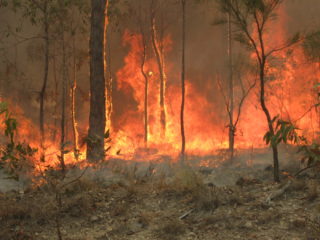-
Australian government floundering from bushfires actually has politically acceptable climate policy options
Date posted:
-
-
-
Post Author
Patrick LaveryCombustion Industry News Editor
-
-
![]()
Australia has been enduring its worst bushfires in recorded history over recent months, attracting international media coverage. Apocalyptic scenes have unfolded – billowing smoke and flames looming over houses, evacuations of communities by boat, streetscapes in the process of incinerating, ghostly aftermaths, landmarks choked by smoke – amidst individual human tragedies, an animal holocaust, the indefatigable work of firefighters and support staff, and touching moments of care. Early hints of regeneration are both hopeful and deceptive, as the fires are expected to continue at least another couple of months, and some habitats may be changed forever. The air quality index (in Australia, this is the highest of a range of indicators – ozone, NO2, visibility, CO, SO2, PM10, or PM2.5, divided by the maximum safe level, multiplied by 100, such that 100 is considered the maximum safe level, 100-200 poor, and above that hazardous) in large cities such as Sydney and Melbourne, as well as the national capital Canberra, has been exceedingly high at times. Canberra hit over 7000 at one stage, while Sydney has reached into the 2000s on multiple occasions. Australia, already with the world’s highest rate of extinction for mammals, is expected to lose even more, with the most recent estimate of animal deaths put at more than one billion.
Wildfires have always been a part of Australia’s ecology, often coinciding with periods of drought and high temperatures. Climate change has undoubtedly made this season’s fires worse, however, contributing both to drought and high temperatures. While in November there were enough people wondering to warrant newspaper articles exploring the question of if the bushfires were unprecedented, such speculation has given way to acceptance. Areas of sub-tropical rainforest previously assumed resistant to bushfire because of their moisture content have burned, and the fires started particularly early this season, reducing the amount of time available for standard ‘hazard reduction’ activities, where relatively cool fires are purposefully lit to reduce fuel loads for uncontrolled fires.
![]()
In parallel with the fires, arguments have raged around Australia as to who or what is to blame, along with much misinformation, and to me it seems that these arguments have been much more pronounced and vitriolic than in any previous fire season. Some (including members of parliament) give the blame chiefly to arsonists, while others (also including members of parliament) claim that a lack of hazard reduction activities have allowed the bushfires to flourish (with some versions of this argument putting the blame for this at the feet of environmental conservationists). Analysis has shown that lightning, rather than arson, has been by far the most frequent cause of ignition of the fires, though some arson has occurred. While it is possible that greater hazard reduction would have curbed the extent of some of them, the weight of experienced opinion suggests the effect would have been limited, though it is acknowledged that land and fire management practices need to be strengthened.
Another target of blame is the federal government for its relatively weak climate change policies and a lack of funding for bushfire preparedness. Prime Minister Scott Morrison has responded – after criticism of his initial position – by agreeing that climate change has been a factor in the fires (exacerbating their natural occurrence), arguing in addition that because Australia’s emissions of greenhouse gases are only a small proportion of the world’s emissions (around 1.3%), they have had negligible effect on the current fires. In this he is probably largely correct, but his implication, in the context, that Australia’s future climate policy choices are insignificant is wrong. Not only is the country amongst the world’s largest coal and natural gas exporters, but its large land mass and plentiful sunshine offer various opportunities for a low-carbon future, and its relative wealth and highly-ranked research institutions can contribute significantly to action against climate change. There is also the logic that Australia is particularly prone to the negative effects of climate change, and if it wants other countries to act, it must itself be seen to act ambitiously.
![]()
Politically, Mr Morrison is in an unenviable position. Many of the people directly affected by the bushfires will have been the ‘quiet Australians’ that he appealed to when he won a surprise election victory last year, and he did not burnish his reputation when, in the midst of the fires, he went on holiday to Hawaii. After his (earlier than scheduled) return to Australia, some people in bushfire-affected communities refused to shake his hand, and he was openly sworn at by some firefighters. Meanwhile, although firefighting is chiefly the responsibility of state governments, in much of public sentiment the duty is federal. There is also the tendency of people to want to find someone to blame for such devastation, which in the past would have been seen chiefly as a natural disaster. But the fact remains that the federal government needs to take stronger climate action, and should have been doing so for years. The Coalition of which he is leader, comprised of the Liberal Party (in Australia, a right-leaning party) and the National Party (a party of farming interests), has over the past decade been fiercely critical of ambitious climate change policies. Prominent party member and former Prime Minister Tony Abbott claimed that the “so-called ‘settled’ science of climate change [is] absolute crap” in 2017 (while giving a mixed overall message), and won the 2013 election promising to repeal the price on carbon that had been instituted by the Coalition’s rivals, the Labor Party. Mr Morrison himself once brought a piece of coal into parliament to show his support for the fuel. Climate policy arguments precipitated numerous leadership changes over the decade, the most recent casualty being Malcolm Turnbull in 2018, who favoured (and continues to favour) a more ambitious policy. But while Mr Morrison won last year’s election against the more climate-ambitious Labor Party, public opinion has now changed from a majority tepidly in favour of policies to mitigate climate change to a majority strongly in favour. The Coalition now appears to know that it needs to adopt a stronger climate change policy, and indeed Mr Morrison has gone public in accepting that climate policy must ‘evolve’, but having attacked so many approaches in the past, it seems the options are now limited.
It’s a natural question, then, to wonder what type of action the Coalition could take that might satisfy the majority of the electorate while not turning a significant part of its support base towards parties that are further to the right, or reopening the internal party conflicts over climate policy.
A look around the world provides some suggestions. One immediate action Australia could take is to set a ‘net-zero greenhouse gas emissions by 2050’ goal, for which there is majority support. (All Australian states have already declared this goal, though the federal government has no goal whatsoever.) A much more ambitious federal 2030 target should also be set: the current one of a 26-28% reduction in greenhouse gas emissions from 2005 levels by 2030 translates (if taking the 28% target) to only a 4.4% reduction from 1990 levels, taking World Bank data on CO2 emissions as a proxy for greenhouse gases as a whole. In comparison, the UK’s target is a 57% reduction from 1990 levels by 2030.
In some ways, it would be more difficult for Australia to achieve greenhouse gas neutrality by 2050 than other countries that have declared the target, such as the UK. Emissions per person are very high, a reflection of numerous factors such as house size, high air conditioning use, long travel distances (and urban sprawl), poor energy efficiency, a relative lack of incentives to reduce emissions, a relatively low proportion of renewables, and the high proportions of agriculture and mining as contributions to the economy. A look at Australia’s exports in comparison to other countries is revealing, as the table below shows.
UK Russia Australia Minerals (including iron ore and coal) 9.7% 58% 54% Metals 12.2% 17% 18.4% Agricultural products 7.4% 9.2% 14.5% Total above 29.3% 84.2% 86.9% Share of sectors in exports, 2017
In terms of exports, Australia’s economy is much more similar to Russia’s than to the UK’s. Minerals, metals and agriculture make up the vast majority of the two countries’ exports. Breaking Australia’s data down a little more, coal was responsible for 19% of exports, and natural gas 8% (the value would be even higher for 2019, as gas exports have risen substantially). Australia would have to find huge sources of alternative revenue if it was to give up on coal and natural gas, meaning it is unlikely to do so quickly. More pragmatically, it must contribute more to carbon capture and storage (CCS) development and deployment, along with clean fossil fuel technology more generally, so that fossil fuels could have a long-term low-carbon future. Agriculture must also receive strong assistance to transition so that it can continue to contribute strongly to Australia’s welfare.
In other ways, Australia has advantages over most countries in becoming net greenhouse gas neutral. Although around 70% of the country is arid or semi-arid, there is still considerable land available for forestry programmes. Abundant sunshine and areas of high wind, as well as promising geothermal and wave resources, provide ample opportunity for higher proportions of renewables, though grid interconnectors will need to be upgraded to properly allow this (which would have the double advantage of providing more grid resilience to future bushfires). But they also point to a future as a ‘green’ hydrogen producer, using renewable energy sources, with an intermediate step as a ‘blue’ hydrogen producer, using coal or natural gas as the feedstock and CCS to reduce CO2 emissions.
It should be acknowledged that in some domains, Australia is not so far behind. It is already taking steps to become a hydrogen producer, with a pilot project of creating hydrogen from lignite being developed in Victoria, in which captured carbon from the process will be stored offshore, the hydrogen shipped to Japan. A national hydrogen strategy was finalised in November 2019. Back in the 2000s, the federal government saw the tension between a country highly susceptible to climate change and an economy heavily reliant on fossil fuels, and set up the Global CCS Institute. The thinking was presumably similar to the Norwegian government in setting up Technology Centre Mongstad and supporting subsequent CCS projects – to create a pathway for a long-term low-carbon fossil fuel industry, being indebted to oil and gas for much of the national export income. As a condition of allowing Shell’s Gorgon natural gas project, it made CCS a requirement, the facility going online last year. Redoubled focus on – and financial support for – CCS should be a part of Australia’s strengthening of its climate policy. Politically, this should be defensible, given that the IPPC, the EU, the IEA and other international organisations recognise the need for a huge expansion of the industry.
This could also be done in line with a national target of phasing out unabated coal firing, much as Germany has set a long-term programme for (which is sometimes misreported in Australia as already being complete). This would walk the fine line between showing support for Australia’s influential and economically important mining industry (by helping institute a long-term future for low-carbon fossil fuel use) and ending some of the country’s most carbon-polluting practices. It would be important, also, as a signal internationally.
Naturally, renewables will be central to Australia meeting stronger emissions targets, and higher targets for the introduction of renewables should be set. Australian research organisations are already world-leading in some areas relevant to climate action. The University of New South Wales, for instance, has pioneered some of the most advanced solar photovoltaic technologies in the world. More support for such research should be provided. Other steps that the federal government could undertake are to set emissions reduction targets for agriculture, and to support research, development and deployment activities to curb agricultural emissions.
The biggest hurdle the government faces is to somehow institute efficient incentives to the economy to decarbonise without the mechanisms being perceived as a ‘carbon tax’. This was the point against which the Coalition was most vitriolic over the past decade, repeating its opposition to the carbon price instituted by the governing Labor Party ad nauseum, and it is difficult to see it taking a U-turn on that just yet. (Such total U-turns within a short period are not without political precedent, however – within the space of a decade in the USA, the Democrats went from being anti-abortion to pro-choice, and the Republicans pro-choice to anti-abortion, as each sought to appeal to different portions of the electorate.) This is despite a cap-and trade system being in keeping with the economic orthodoxy usually championed by the Coalition. Its own attempt at an alternative, where it took bids from companies to reduce carbon emissions, awarding contracts to the most cost-efficient, was initially surprisingly effective, with the price of a tonne of CO2 being reduced for AU$11-14 (US$7.6-9.7, €6.8-8.7), well below the initial AU$23 of the pricing system it had replaced (the price rose thereafter), but has since attracted little interest from businesses and is effectively inoperative now.
Alternatives might be to set standards for carbon intensity (i.e. carbon emissions per unit of output – here the government already has some targets for the economy as a whole) across different industries, or simply to mandate that certain industries must reduce greenhouse gas emissions by certain percentages by certain milestone dates, with hefty fines attached to non-compliance. Such standards would provide some flexibility for businesses to decide the most efficient way to achieve them, while reducing overall emissions. Many businesses, including major mining companies such as BHP, have already announced their own targets. In time, as the political mood changes further, a carbon pricing system might be reinstituted, perhaps with the ‘excuse’ that trading partners such as the EU will impose a carbon border tax anyway.
Overall, a mix of economically savvy choices for industry and the economy, combined with goal setting that allows some flexibility for approaches to reducing emissions, should be available that would be politically acceptable while producing concrete reductions. This is also the opinion of economist Professor Ross Garnaut, who led two governmental reviews of climate change economics a decade ago. More extreme natural disasters will be a fact of life for Australians in the future, as climate impacts lag emissions, but if they can be somewhat less extreme, that would be welcomed by everyone.



